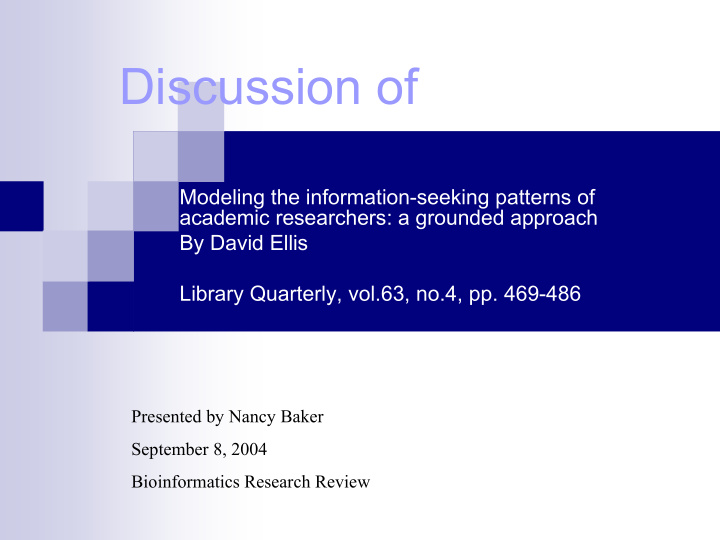



Discussion of Modeling the information-seeking patterns of academic researchers: a grounded approach By David Ellis Library Quarterly, vol.63, no.4, pp. 469-486 Presented by Nancy Baker September 8, 2004 Bioinformatics Research Review
What is “grounded theory”? � Grounded Theory is most accurately described as a research method in which the theory is developed from the data, rather than the other way around. That makes this is an inductive approach, meaning that it moves from the specific to the more general.- A. L. Davidson � The phrase "grounded theory" refers to theory that is developed inductively from a corpus of data. If done well, this means that the resulting theory at least fits one dataset perfectly. This contrasts with theory derived deductively from grand theory, without the help of data, and which could therefore turn out to fit no data at all - Steve Borgatti
The Research Problem � Derive models of the information seeking patterns of academic researchers � Social science � Sciences � Humanities
What approach is best to take? � Traditional approach – questionaire and statistics � Discussion of objectivist vs. subjectivist
Objectivist vs. Subjectivist � Realist ontology � Nominalistic ontology � Positivist � Antipositivist epistemology epistemology � Deterministic view of � Voluntaristic view of human nature human nature � Monothetic � Ideographic methodology methodology
or … � Objectivist views � Individual cognition social world as having important an existence as hard � Getting inside and concrete as the situations by natural world evaluating subjective accounts
Paradigm shift � From large groups and questionaires � To small groups, interviews, observation � Ellis selects this second method
Next, what models existed for information-seeking? Should they be used? � Information retrieval model � Misleading � Parody � Information man model � Primitive
Model? � These models not good enough. Ellis decides on a different approach – grounded theory. � Doesn’t start with model � Will generate models and theories from data
Procedure � Choose sample � Wanted a comparison of social scientists, scientists, and humanities researchers � 18 physicists � 14 chemists � 10 English lit researchers
Procedure (cont.) � Method � Discusses pros and cons of direct observation � Interview method was decided on � Interviews were recorded and transcribed � Look at questions in the appendix or examples � Interviewer could ask other questions � Coded � Did not use predefined paradigm
Method of analysis in Grounded Theory � Constant comparative method – 4 aspects � Comparing incidents applicable to each category � Integrating categories and their properties � Delimiting the theory � Writing the theory
Unclear? Time for an example. � Psychologist � Look at response � Features boiled down to � Starting (identification of key paper to start search) � Chaining (following up on references) � Browsing (to identify relevent journal sources) � Extracting (working through material in rel.sources) � Monitoring (maintaining awareness of area) � Differentiating (employing differences to filter material)
Another example: education researcher � Starting (employment of online search to locate refs) � Differentiating (between journals, publishers) � Monitoring (publishers’ lists and journals) � Extracting (from publishers’ lists, jounals)
Synthesis of social scientist findings into a model � Six categories sufficient to represent generic features of information-seeking � Starting � Chaining � Browsing � Differentiating � Monitoring � Extracting
Model for physicists � Initial familiarization � Chasing � Source prioritization � Maintaining awareness � locating
Model for Chemists � First six same as social scientists � Add verifying and ending
Model for English literature researchers � Starting � Surveying � Chaining � Selection and sifting � Monitoring � Assemble and dissemination
Conclusions � Many of the same activities are modeled � Study showed internal coherence and consistency of findings � Comparison to other studies showed accurate representation of information- seeking behavior
Conclusion about grounded theory approach � Can perceive the issues from the orientation of those studied � Step toward building accurate models
Questions? � Is this a common approach in information science research? � What are the drawbacks of the approach? � When would you use this approach in a study?
Recommend
More recommend